When you plant a pomegranate tree, Punica granatum, you’re most likely hoping that it’ll be productive for a long time to come.
It’s necessary to have patience, as it can take a few years before the plants begin to produce fruit.
Each season, you’ll be waiting at least six months from the time they set fruit in spring or summer until they’re ready to harvest, typically in late summer or fall.
While you’re playing the waiting game, there are several factors that not only affect how the fruit matures, but that can impact how successful the yield will ultimately be in terms of quality as well.

We link to vendors to help you find relevant products. If you buy from one of our links, we may earn a commission.
Some of these factors can lead to an unfortunately common outcome: cracked or split fruit. What was once a semi-round, leathery globe is suddenly a mess of exposed, decaying arils, still attached to the limb.
Why does this happen? How can we prevent it? Let’s take a closer look.
Why Pomegranate Fruits Split on the Tree
1. Water Stress
Pomegranate trees or shrubs prefer to grow in semi-arid to arid conditions, where humidity is relatively low for the majority of the year. Obviously, regions that have an arid climate have little average annual rainfall.
When the plants are blooming and producing fruit, which occurs simultaneously between spring and fall, they typically require more water.
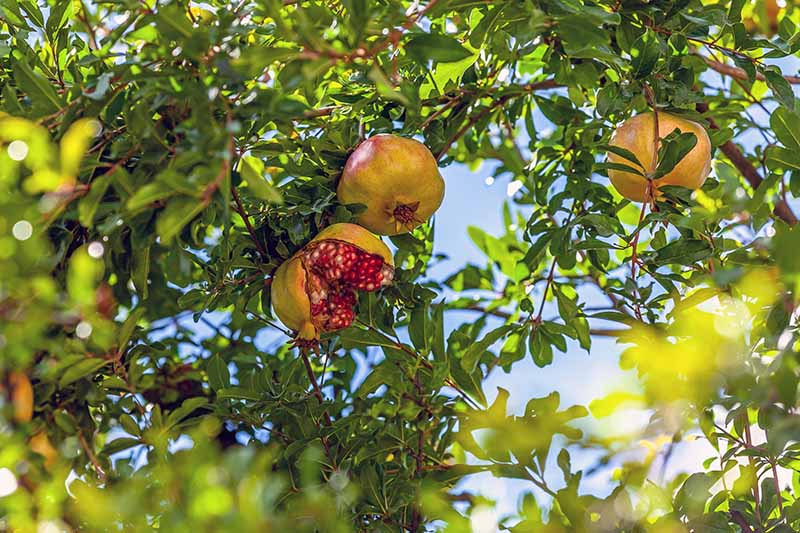
It’s necessary to provide one inch of water per week to maintain healthy fruit production in the absence of rainfall.
Overall, pomegranates require about 45 to 60 inches of rain per year. A rain gauge can help you to track how much precipitation your garden receives.
If the plant doesn’t receive enough water, especially during periods when temperatures are high, the fruits will begin to dry out.
This can lead to dropping if the issue is not corrected, as the tree struggles to retain moisture and conserve energy.
As moisture is lost, the flesh-coated seeds on the interior, known as arils, will begin to shrink in size.

The rind, known as the pericarp, will also shrink and dry to compensate for the reduced size of the interior arils. As the rind dries out, it loses elasticity.
If it then rains heavily, or if supplementary water is suddenly provided, the tree will quickly take it up. The water then begins to diffuse back into the fruits, replenishing the fluids and causing them to expand.
Because the pericarp has shrunken, hardened, and lost elasticity, it can’t expand adequately, and will crack instead.
In some cases when the pericarp is not able to expand, the fruit can split entirely, opening up and exposing the arils.
Overwatering in the fall in particular, when the majority of the fruit is ripening, will likely lead to cracking.
Tips for Preventing Water Stress
If you live in a region where rainfall is scarce, it’s best to provide one inch of supplementary water per week, per plant, to keep pomegranates from becoming stressed in times of drought.
It can be easiest to install an irrigation system for watering multiple trees or shrubs, or if you sometimes forget to water your plants. It’s up to you how elaborate of a system you’d prefer to use; they can vary widely in configuration and range in price.
A good basic kit that can be attached to the exterior hose faucet is this one, available from Home Depot.
This system includes drip irrigation tubes and micro-sprinklers which can do the trick to keep plants watered on a budget, or in a smaller area such as a residential yard.
If you’ve got a larger area or more plants to provide water for, you might consider a system that can easily be expanded to cover a larger zone ,and set it to water on a schedule, using a timer to get the job done even if you forget.
But water stress is not the only reason that fruits might crack or split on the tree. Let’s take a look at nutritional issues next.
2. Nutrient Deficiencies
While pomegranate plants are generally very tolerant of harsh conditions such as drought, high heat, and poor soil, these conditions can sometimes cause stress nonetheless, and lead to growing issues.
Poor soil that is low in organic material or high in clay or sand can lack essential nutrients that support plant growth, as well as bud and fruit development.
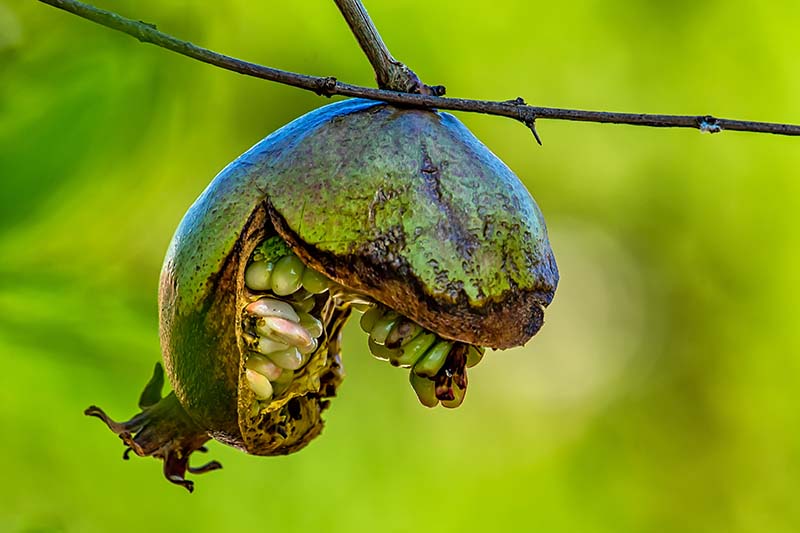
Without these nutrients, many signs of distress may become evident, such as stunted growth, discoloration, and bud drop.
Deficiencies can also lead to several issues with developing fruit, particularly in the early stages.
Fruits that do not receive enough potassium or calcium may show signs of chlorosis, or discoloration that presents as “bleaching,” which can preempt cracking and splitting.
Tips for Preventing Nutrient Deficiencies
Prevention is the best method for addressing deficiencies, as it’s much easier to amend the soil ahead of time than it is to try to correct poor growth or damage after the fruit has formed.
If the fruits are already cracking, unfortunately it’s going to be too late to correct for the current growing season.
Soil testing prior to planting, or in late winter or early spring to check on the planting area for existing trees, can paint a picture of the overall health and nutrient availability of your soil.
If test results show that the soil is lacking in nutrients, you’ll most likely need to apply fertilizer.
Pomegranates don’t prefer heavy applications, so it’s important to choose a suitable fertilizer type and method of delivery for the best results.
For complete information, see our guide to fertilizing pomegranates.
3. Temperature Fluctuations
Rapid or extreme changes in temperature can also lead to cracking. Even though they’re generally very heat-tolerant, a large jump from low to high temperatures can still cause damage.
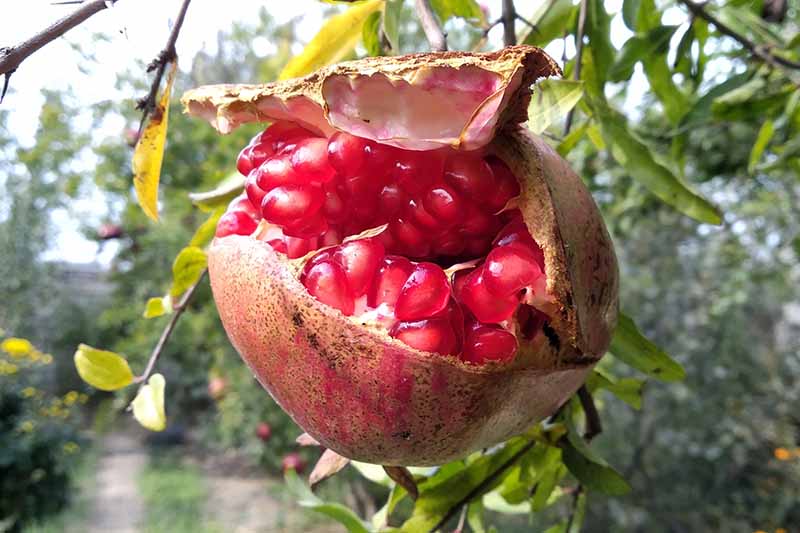
This is known to occur commonly in desert regions where overnight temperatures can be below freezing, while daytime temperatures can climb to over 80°F.
Extreme heat can cause the plant to take up more water as an emergency measure, in an effort to counter moisture loss due to transpiration. When this occurs, the arils inside may expand as they swell with fluid.
Swollen fruits will crack, as the tough rind can’t stretch to accommodate the enlarged arils.
Tips for Protecting Plants from Temperature Fluctuations
Unfortunately, it’s very difficult to prevent cracking due to temperature changes, but making sure your plant is adequately watered can help.
Covering or moving potted plants to provide shade or protection from cold can also help if you are growing a dwarf tree in a container.
4. Overripening
All plants have a natural growth cycle, and the goal of this is to propagate more plants, guaranteeing survival of the species.
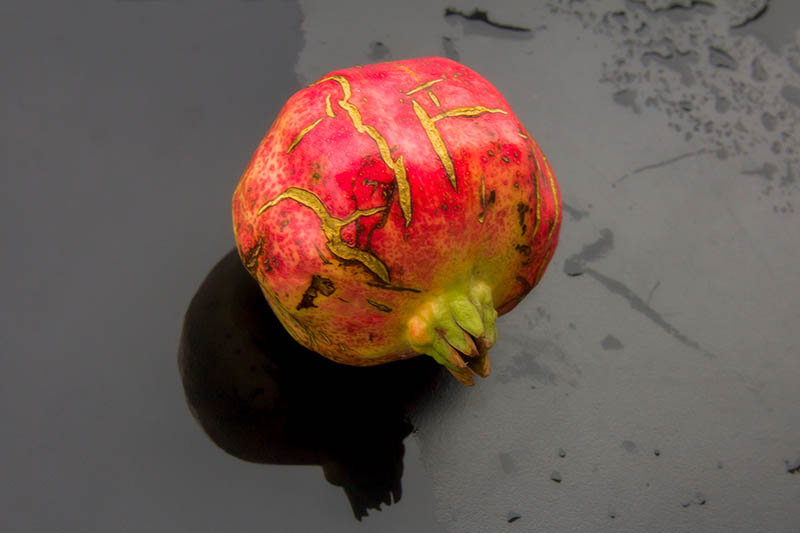
Pomegranates are no different. If fruits are left to ripen past their prime, they’ll naturally begin to split open, casting seeds onto the soil below, or becoming food for birds and other animals that carry the seeds away to grow in other locations.
Tips for Preventing Overripening
It can be tricky to know when the fruits are fully ripened and ready for harvest. Unlike others, such as peaches or apples, pomegranates won’t exhibit significant changes in the color or texture of fruit that indicate when it’s time to pick.
For full details on the signs to keep an eye out for when picking pomegranates, including how to tell when they’re ripe, see our guide.
5. Heart Rot Disease
Though pomegranates are hardy trees that are not known for being particularly susceptible to disease, one in particular is known to lead to split, rotten fruits.

Heart rot, also known as black heart, is caused by the fungus Alternaria alternata. This fungus penetrates the calyx of blooms, and then remains dormant until the bloom becomes fruit.
The rind remains normal in appearance and can even fully ripen, but the interior will become infected with the fungus, turning black as the arils rot.
Tips for Preventing Heart Rot Disease
At this time, there’s no known cure for heart rot, although application of a fungicide early in the growing season may deter infection.
Learn more about heart rot, and other diseases, in our complete guide to pomegranate pests and diseases.
Is It Safe to Eat?
It’s important to note that split fruit is not necessarily ruined. You should always take a close look at whatever you pick prior to discarding it.
Cracked pomegranates may be salvageable if the interior pith is not breached, and the arils remain protected and moist.

Even those that split open widely could still be usable if you’re able to catch them early on.
The interior may still be edible as long as the arils are not shriveled or showing signs of rotting – if birds and insects don’t get to them before you do, that is.
If the cause of splitting is a fungal disease – which may cause discoloration, rotten arils, gray mold, or soft spots in the pericarp – the fruits should not be consumed.
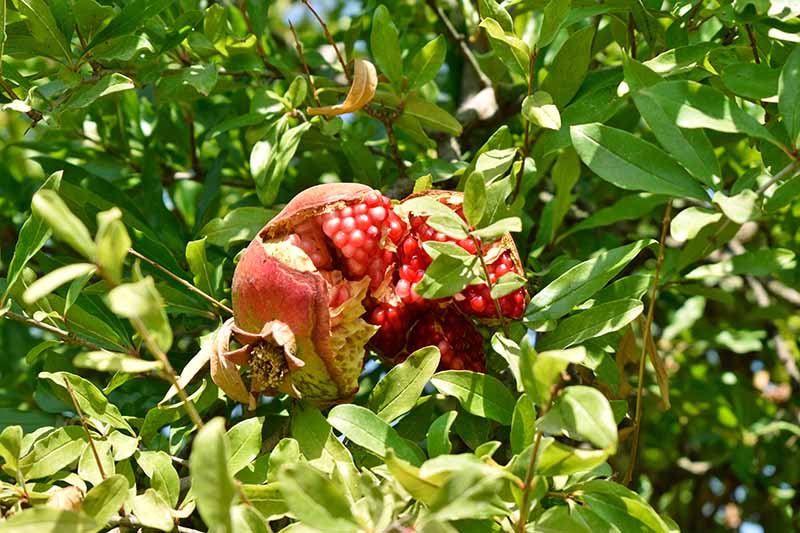
Instead, they should be discarded in the trash to avoid spreading pathogens throughout your yard or garden.
Do not place spoiled fruits that show signs of disease on your compost pile, or near other plants where they may contribute to further spread.
Even Tough Plants Have Their Weaknesses
Despite this rather common issue, growing pomegranates can be incredibly rewarding and fun.
Their distinctive form and flavor, coupled with their tremendous nutritional value, make it well worth the effort required to grow them.

Is this your first year as a pomegranate cultivator, or are you a seasoned veteran? Have you experienced fruit cracking or splitting? We’d love to hear about your experience, and see some pictures of your successes in the comments below!
And if you still have more questions about growing fruiting pomegranates, you might like read these guides next:
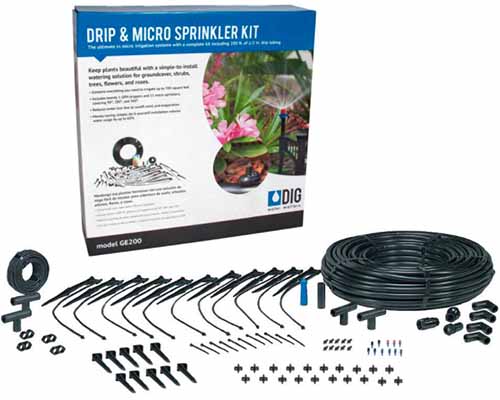
This is my second season for my pomegranate tree. We have it on a drip system so it has regular watering. Last year we had a huge lot of pomegranates but this year not as many and they are cracking open before fully ripe. I have plenty of mulch under the tree, is there something different I should be doing to stop it from cracking open?
Hi Shannon,
I’m sorry to hear that your pomegranates aren’t making it to ripeness in one piece, that is a frustrating problem.
Can I ask if there have been wide temperature fluctuations this year? Sometimes, a drastic change in temperature from daytime to nighttime can cause cracking.
Nutrient deficiencies are a common cause as well – are you noticing any discoloration, such as chlorosis? If so, could you post a photo and I can try to help you?